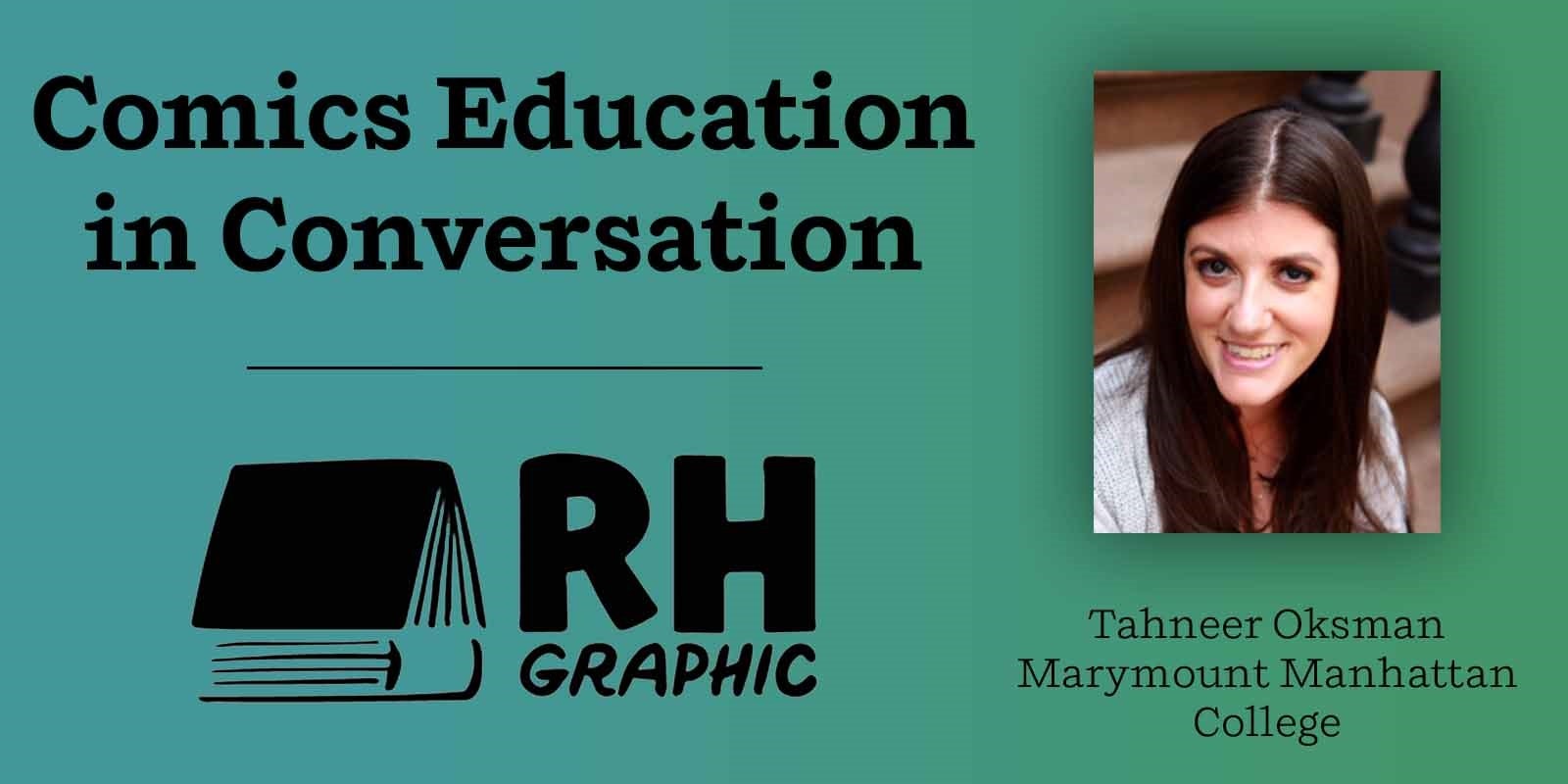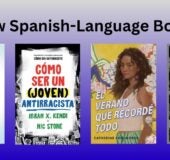Tahneer Oksman is Associate Professor of Academic Writing at Marymount Manhattan College, where she teaches courses in writing, literature, and cultural journalism. She is author of “How Come Boys Get to Keep Their Noses?”: Women and Jewish American Identity in Contemporary Graphic Memoirs (Columbia University Press), and co-editor of The Comics of Julie Doucet and Gabrielle Bell: A Place Inside Yourself (University Press of Mississippi. You can find links to her comics journalism on tahneeroksman.com.
How did you get started reading comics?
As a kid, I read tons of Archie comics. Part of the attraction was that I went to school in Riverdale too, although my own experience of going to a Jewish day school was completely different from the kids in the comics. Girls weren’t allowed to wear pants at my school. I’m sure that was a huge part of the appeal: just seeing what Betty and Veronica and the others were wearing, and witnessing a bunch of kids actually hanging out in their own neighborhood (I was a commuter kid).
I also loved reading my older brother’s MAD magazines, which felt delightfully illicit—not just for the content but because I wasn’t supposed to touch my brother’s stuff! Then, at about twelve years old, I found a copy of the collected Maus somewhere in the house, and I was just stunned. I’d read many books about the Holocaust, including memoirs, because my grandfather and his sister were survivors, but this was unlike any book I’d ever read.
How did you get from your first comics-reading experience to doing academic work in the medium?
In graduate school, I became interested in autobiography studies after I took a class called Postmodern Memoir. I was interested in the books themselves, but also in all of the theoretical questions you ended up asking about them: What makes something true, especially if it’s culled from memory? How do you account for competing versions of the past?
During my PhD Program, I met and worked with people who had been studying these questions for a long time. I was especially drawn to theories of photography, which often addressed what happens when you put words and images together. Eventually, I found Aline Kominsky Crumb’s Need More Love in a bookstore bin, and fell head-over-heels. I had no idea how to write or talk about visual texts at first, but I also knew I just had to write about it. Then Hillary Chute’s first book, Graphic Women, came out, and I saw that I could write not just a chapter but a whole dissertation about comics.
Have you seen a change in the academic and/or popular reception of comics and graphic novels over the course of your career?
Sure—to a point. Most students I teach these days have at least had some experiences with comics, whether having read Jeff Smith’s Bone series, or books by Raina Telgemeier, or having been hooked on the Marvel comics universe from a young age. It’s not difficult to get these students excited about all the different work being put out there; all you have to do is show them some good stuff and introduce them to the right resources. I’m especially happy that there are more and more people focused on expanding representation in comics.
But I still find myself pushed into a defensive position sometimes. There are a lot of biases still out there regarding what makes a piece of art, or literature, valuable, or worth someone’s time—whether for pleasure or as an object of study. Recently, for example, the parent of a third grader told me that her kid’s school was discouraging the students from reading comics so they could move on to “more serious literature.” Her kid, by the way, was totally obsessed with comics, and I don’t think will be dissuaded from reading them anytime soon.
You’ve done academic work with comics that centers women and the Jewish identity – can you tell us a little about that?
When I was in graduate school, I went to see my advisor one day, and she asked me, “Do you realize all of the books you want to write about are by Jewish women?” This was a bit startling to me; because of my complicated relationship to my upbringing, I’d spent a lot of my twenties trying to get away from my Jewish roots, or so I thought.
Of course, it made perfect sense that this is what I was drawn to. My relationship to Jewishness was a puzzle I had yet to solve. It was in reading comics by other women with complex relationships to their Jewish identities—cartoonists like Kominsky Crumb, but also Lauren Weinstein and Sarah Glidden, for example—that I started to get a better understanding of my own connections and complications. I was especially drawn to the ways that comics can expose people’s often conflicted relations to certain parts of themselves.
You’re a professor of Academic Writing, and you teach graphic novels as part of that. What has the response been to that, with your institution and with your students?
In general, there’s pretty widespread acceptance in higher education to using comics—and visual rhetoric more generally—in order to teach writing. It can be really useful, for example, to teach students how to find evidence in a text by having them just look at a page from Persepolis together. Because students generally aren’t used to close reading comics texts, certainly not in a classroom setting, it can refresh their approaches to, and investments in, reading and writing once they get to college.
Every once in a while, I do get a little pushback in the classroom, but it’s pretty rare. I remember once I had a student complain about reading Lynda Barry’s 100 Demons, insisting he hadn’t come to college to read kids’ books. But the truth is, even the most resistant students come around once you start to question their assumptions. I ask a lot of questions: What makes something a children’s book? What makes something a piece of art? Of course, in the end, I probably don’t even need to do all of that work because once they actually crack open the books, the texts speak for themselves.
As well as your academic work, you do some reviewing and interviewing. How do those two intersect?
I’m so glad you asked me this question because it’s one of my favorite things to think and talk about. I started reviewing comics when I was a graduate student, frankly because I couldn’t afford the books I wanted to read and reread. From there, I went on to regularly reviewing comics in various literary outlets, oftentimes as a way of trying out an approach to a text in a short space. It’s also a great way to flex your writing muscles under deadline, and stay connected to an audience outside of academia.
I especially love when I get to interview people about their work; it’s an incredible privilege to get to talk to the people whose books you spend so much time reading and writing about. I have learned more about how comics work from hearing about different artistic processes than I could ever learn from just reading theories in books about how comics work.
One thing that sometimes happens when I interview a cartoonist is that I find myself disagreeing with something they say about their own text. I love it when this happens! Once you put your work out there, it doesn’t belong just to you anymore—I think there’s something magical about that. And, of course, I learn so much from those conflicting points of view, and I think, I hope, that they do too.
There’s long been a call for increased diversity in comics – and that’s only gotten more prominent. What are you seeing changing in this space today?
I remember when MariNaomi first announced her Cartoonists of Color database. I was so relieved because I finally had a resource I could share with students who approached me. Nowadays, I have many more resources at my disposal. This is where I find social media especially useful. If a student tells me, for example, that they’re looking to connect with a particular comics community that they are not sure even exists, and I am not sure either, well, let’s just say Twitter has all of the answers.
I also recommend Instagram as a way of finding new artists, or academics, or groups who are invested in certain topics or themes. I think that having a lot of comics conventions and events online has broadened accessibility in mostly wonderful ways, and I hope that’s something that continues long after the pandemic is (hopefully) somewhere behind us.
Favorite or new graphic novel recommendations?
These are not totally new, but my local library just finally reopened and got an influx of new books—including volumes 2 and 3 of the Akissi series (by Marguerite Abouet and Mathieu Sapin). I’ve been delighting in these with my boys, aged 9 and 6. Also not so new, I just re-taught and re-read Ebony Flowers’s Hot Comb, and every time I open that book I find something I didn’t see before. More recently, I just read Sharon Lee De La Cruz’s I’m a Wild Seed, which is a visual pleasure—it’s a short but powerful book. And I also just started enjoying an interesting graphic biography, A Revolution in Three Acts: The Radical Vaudeville of Bert Williams, Eva Tanguay, and Julian Eltinge, by David Hajdu and John Carey (which will be coming out officially in September).
SOCIAL MEDIA
Twitter: @TahneerO
Website: tahneeroksman.com





